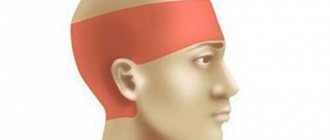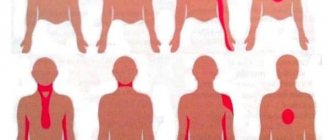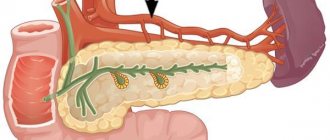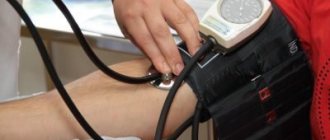Pathology of the cardiovascular system
Nervous tissue is more sensitive to oxygen deficiency than any other tissue. Therefore, the cranial cavity contains a large number of blood vessels and venous plexuses. A disruption of the blood supply or blood flow from the central nervous system immediately leads to pain.
Hypertonic disease
This is the name for an increase in blood pressure above 140/90 mmHg. Headaches with hypertension are of a different nature. The typical one is a leaden heaviness in the back of the head, more pronounced in the morning and gradually subsiding in the evening. It occurs due to excess blood flow and stagnation in the venous plexuses of the skull.
Another type of pain syndrome occurs during a hypertensive crisis. In this case, it acquires a bursting or pulsating character; the following are added:
- nausea;
- dizziness;
- ringing in the ears;
- flickering of flies before the eyes.
It happens that some types of nervous activity are lost: vision, hearing, speech. All these symptoms disappear after the crisis subsides.
Atherosclerosis
With this disease, cholesterol molecules are deposited in the vessel wall, which leads to the formation of plaques, poor circulation and the formation of blood clots. Symptoms of cerebrovascular disease:
- dizziness, especially when throwing your head back;
- darkening of the eyes or spots before the eyes;
- dull or aching pain in the head;
- noise in ears.
All of them appear in response to a decrease in blood flow to the brain tissue. Atherosclerosis often causes memory and thinking disorders.
Vascular diseases
Headache attacks occur when the blood circulation in the brain is disrupted. At the same time, blood pressure often increases, dizziness and tinnitus appear. The symptomatic picture is complemented by attacks of nausea and vomiting, rapid pulse, shortness of breath, hyperthermia or pallor of the face.
The main vascular diseases causing cephalalgia:
- Atherosclerosis of cerebral vessels is the accumulation of cholesterol plaques on the walls of veins, arteries and capillaries. Atherosclerotic deposits impede the movement of blood, which provokes a deterioration in blood supply to the brain, causes unpleasant symptoms and is the cause of other diseases.
- A vascular aneurysm is a pathological expansion of the lumen of an artery, which fills with blood and expands in size. If the aneurysm itself does not cause serious symptoms, its rupture can lead to dangerous consequences.
- Angioma is a limited expansion of veins or of veins and arteries, which is a tangled tangle of vessels. An angioma fills with blood and can vary in size, occurs on the skin, but sometimes affects the brain.
- Vegetative-vascular dystonia is a complex of thermoregulation disorders with a pronounced disturbance of the tone of the vascular walls. VSD is not an independent disease, it is a syndrome that occurs against the background of any pathologies or lifestyle disorders.
- Cerebral ischemia is a cessation of blood supply to any part of the brain, causing oxygen starvation. The most common cause of ischemia is atherosclerosis.
- Violation of venous outflow - or venous discirculation. The disease is a disorder in the movement of blood from the brain to the heart.
- Fainting – loss of consciousness occurs as a result of disruption of the blood supply to the brain tissue. Fainting can last from 5 seconds to 4-5 minutes. If the patient does not regain consciousness for a longer time, it is necessary to call an ambulance.
- Cerebral angiodystonia is a violation of vascular tone. Most often occurs against the background of other diseases.
Pathology of the nervous system
The brain is located in a closed cavity - the skull. The inside is lined with meninges and filled with cerebrospinal fluid - cerebrospinal fluid. It is produced by the choroid plexuses of the brain, which respond to the disease by increasing fluid secretion.
There are no pain receptors in the nervous tissue itself, so brain diseases lead to pain only when the meninges, which are richly supplied with such receptors, are irritated. Due to the increase in the volume of cerebrospinal fluid, the pressure inside the skull increases, to which the dura mater reacts. Pain appears, which is bursting in nature, intensifies when the head is tilted down, and is accompanied by nausea and vomiting. The latter does not bring relief, which is its distinctive feature.
The same symptoms appear with brain tumors, only the pain is constant and gradually progresses.
Streptococcus aureus, which causes rheumatism, often causes damage to the nervous system. Pain in the head with this pathology of a bursting nature occurs periodically. It is accompanied by epileptic seizures, uncontrolled movements of the body and facial muscles, sudden changes in mood, and severe weakness.
One of the causes of headaches in pathologies of the central nervous system is vegetative-vascular dystonia.
Migraine is intense pain that is localized strictly in one half of the head. Before an attack, a person may experience auditory, visual, or olfactory hallucinations. The reasons have not yet been established, but a connection has been noticed with a person’s character: migraines affect people who are motivated and talented.
Brain tumors
Cysts and brain tumors put pressure on nearby healthy tissue, causing unpleasant symptoms. In almost all cases, headaches are accompanied by dizziness, which is most pronounced in the morning after waking up. With brain tumors, attacks of nausea and vomiting, deterioration of memory and concentration, and impaired coordination of movements and speech are noted.
Tumors that cause headaches:
- Pituitary adenoma is a benign neoplasm that grows from the glandular tissue of the anterior lobe of the brain. The pituitary gland is the central organ of the endocrine system, so when an adenoma develops, hormonal disorders occur.
- Astrocytoma is a malignant brain tumor that grows from neuroglial cells. At the initial stages it has clear boundaries. Cysts sometimes form inside the tumor.
- Glioblastoma is a malignant tumor that occurs as a result of disruption of glial cells. The development of the tumor is influenced by other tumors. Glioblastoma is characterized by rapid growth.
- Meningioma is a tumor growing from cells in the meninges. In the initial stages, this is a benign formation, but can develop into a malignant form.
- A cyst is a benign formation in the form of a cavity filled with cerebrospinal fluid. The size of the cyst can vary; the larger its diameter, the more pronounced the clinical manifestations.
Eye diseases
Visual impairment leads to overstrain of the eye muscles, which work hard to ensure visual function. The pain is dull, aching in nature and begins in the frontotemporal region. If the visual load continues, pain affects the parietal areas and spreads all the way to the back of the head. Thus, the pain takes on a girdling character.
The disease glaucoma develops when the pressure inside the eye increases. In this case, overstrain of the oculomotor muscles also occurs, but an additional role is played by reflex irritation of the nerve receptors of the orbit.
Pain in this case:
- occurs against the background of attacks of glaucoma;
- more pronounced on the side of the diseased eye (with a unilateral process);
- not relieved by taking painkillers.
Organic brain lesions
Various neurological diseases accompany headache symptoms, but only 5-7% of them are associated with organic brain damage.
Identifying the main cause of the disease and eliminating it is the main task of a highly qualified neurologist. From a pragmatic point of view, the specialist first excludes the main forms of cephalgia, such as migraine, tension headaches, and cervicogenic headaches.
At the same time, the neurologist is actively searching for neurological clinical confirmation of the preliminary diagnosis - symptoms and signs of organic brain damage. For this purpose, the patient’s life history and the history of the disease itself are carefully collected: the presence of negative individual habits, the intensity and duration of discomfort, its localization, the presence of concomitant other manifestations.
Carrying out a diagnostic examination, for example, ultrasound to exclude kidney damage, EEG, ECG, various blood tests will contribute to an adequate differential diagnosis:
- intracranial hypertension – characterized by high cerebrospinal fluid pressure parameters, acceptable neurological symptoms, absence of space-occupying tumors according to brain MRI;
- obstruction of the free circulation of cerebrospinal fluid in intracranial structures occurs in diseases such as hydrocephalus, cerebrospinal fluid fistula, post-puncture pain - diagnosis and treatment should only be carried out by a neurologist; in the absence of adequate medical care, the consequences will be very serious;
- Timely detection and implementation of treatment procedures is extremely important for diseases such as meningitis, encephalitis, malignant tumors, and sarcoidosis.
If there are any doubts about the adequacy of the diagnosis of the disease, the neurologist will recommend consultation with other specialists, for example, an infectious disease specialist, an ophthalmologist, an oncologist.
Diseases of the ENT organs
Pain in the head always accompanies ENT diseases, since the affected organs have a direct connection with the bones of the skull.
Sinusitis
Inside the bones of the skull there are vast voids - sinuses or sinuses. They open into the nasal cavity and are lined with mucous membrane on the inside. During inflammatory processes, the sinuses can fill with mucus or pus, which creates excess pressure in them. Pain receptors in the mucous membrane are irritated and pain appears.
Its localization depends on which sinus is affected:
- Frontitis (inflammation of the frontal sinus) causes pain in the frontoparietal region.
- Sinusitis (inflammation of the maxillary sinus) - in the area of the bridge of the nose, cheekbones, may resemble a toothache.
Sometimes pain affects the entire face. They are of a bursting nature, intensified by tilting the head and lightly tapping the bones of the skull.
Ear diseases
Inflammation of the ear (otitis media) causes acute throbbing pain in the temporal region. Increased pain indicates the development of complications. Severe bursting pain behind the ear is a sign of inflammation of the process of the temporal bone; bursting headache is associated with meningitis. If a tumor appears in the ear cavity, the pain syndrome is dull, bursting in nature and increases as the tumor grows.
Diseases of the mouth and pharynx
Inflammatory diseases of the pharynx and oral cavity are usually infectious in nature. Therefore, the pain syndrome with them occurs as part of general intoxication of the body. He:
- does not have a clear localization;
- characterized by aching character;
- intensifies in the evening.
You can learn everything about the treatment of headaches by reading this article. Not only medications, but also folk remedies are effective in treating headaches.
Classifications of diseases that cause headaches
There are many different diseases that can lead to secondary headaches. These diseases can be grouped into eight main classifications.
Head or neck injuries as a cause of headaches
Obviously, head and neck injuries can lead to the development of headaches. The injury may be classified as mild, moderate or severe, for example:
- concussion
- whiplash injury
- brain contusion (traumatic brain injury)
It has been found that pain associated with temporomandibular joint dysfunction (TMJ) resulting from a road traffic accident may occur with a delay of 6-12 months after a person is involved in an accident.
Vascular diseases of the head or neck as a cause of headaches
Diseases of the blood vessels in the head and neck can obstruct the flow of oxygen to the brain. Among the diseases and pathological conditions of this group that can lead to the development of headaches include:
- stroke
- transient ischemic attack (TIA)
- diseases of the carotid arteries (carotid artery stenosis)
- inflammation of the arteries of the head and neck
Find out more about vascular diseases of the circulatory system.
Non-vascular brain diseases as a cause of headaches
This group of diseases that can cause headaches in humans includes:
- tumors
- convulsions
- excess cerebrospinal fluid pressure
Side effects from medications and headaches
Severe headaches may occur when taking certain medications. Chronic headaches can occur when you take painkillers and other types of medications in excess. You can learn about this in detail here – Abuse (medicinal) headache.
Infection as a cause of headache
Viral or bacterial infections of the head and neck, one of the symptoms of which is headache, include the following diseases:
- meningitis
- encephalitis
- pneumonia or other systemic infections
Imbalance in body systems as a cause of headaches
The body is designed to maintain homeostasis and when the balance in the body's systems is disturbed, it is very common for a person to experience headaches. Here are some reasons why imbalances occur in the body:
- high blood pressure (hypertension)
- dehydration
- renal failure
- thyroid problems
- allergies
- sleep disorders (especially sleep apnea)
Diseases of the eyes, ears, nose or throat as a cause of headaches
The most common problems occur with the trigeminal nerve and the temporomandibular joint. Read: Headaches in the forehead and eyes, temples and back of the head.
Mental disorders
The cause of secondary headaches can also be mental and psychological disorders, and vice versa, headaches can be the cause of mental and psychological disorders.
One of the main problems for many patients is that their doctors assume that their patients' psychological state is the cause of their pain. It is vital to distinguish between headaches and psychosomatic headaches.
Psychosomatics : Simply put, psychosomatic pain is pain that occurs as a result of a mental disorder.
Somatopsychics : here the opposite is true - as a result of feeling a constant severe headache, a person develops mental disorders. If you experience constant severe pain, it is likely that you will develop permanent depression and the pain will simply drive you crazy. Depression is a secondary symptom in relation to headache, and is not the cause of its occurrence.
If everything is fine with your psyche, and you do not visit a psychologist or psychiatrist, and the doctor you see attributes pain symptoms to psychosomatics, you should also consult with another doctor (doctors), as he may be mistaken.
Patients with somatopsychic pain quickly get rid of depression if pain was the root cause of their psychological condition.
Infectious diseases
Most pathogens produce toxins that damage the vascular wall. Its permeability increases, so blood plasma and its cells escape into the surrounding tissues. So, they appear:
- swelling;
- hemorrhages;
- in the case of the brain, the secretion and volume of cerebrospinal fluid sharply increases.
Many infectious diseases cause inflammation of the dura mater - meningitis. The pain with it is bursting in nature and covers the entire head. Without treatment, it constantly increases, reaching unbearable intensity. Nausea and vomiting like a fountain are a frequent companion to irritation of the meninges.
Flu
The virus that causes influenza disease has the greatest damaging effect on blood vessels. In severe cases of infection, a person dies from swelling and hemorrhages in various organs.
Headache is one of the first symptoms of the flu:
- It is localized behind the eyes.
- It is oppressive in nature.
- Its intensity increases rapidly.
- Gradually takes over the entire head.
- It takes on a bursting character due to irritation of the meninges by the excess volume of cerebrospinal fluid.
Diagnostics
Identifying the underlying problem or disease is important to eliminating headache symptoms. Secondary headaches often present in the same way as other types of headaches, and you may not always be able to accurately determine what exactly is causing them and how serious they may be.
Your doctor can refer you for diagnostic procedures, which will help him make the correct diagnosis and prescribe the right course of treatment. These diagnostic procedures may include the following:
- Magnetic resonance imaging (MRI)
- Computed tomography (CT)
- Electroencephalography (EEG)
Before treating a headache, the neuromuscular dentist will also perform a series of diagnostic procedures, including:
- X-ray examinations of the jaws
- Jaw joint examination
- Sinus examination
- Dental examination
- Electromyography (EMG) – assessment of neck and jaw muscles, assessing muscle health and function
- Computed Mandibular Scan (CMS or MKG) to assess jaw mobility and function
- Diagnostic applications of electrical myostimulation (TENS)
These diagnostic procedures can be an extremely important step in making the correct diagnosis and prescribing effective methods of treating the disease, which must necessarily lead to a complete recovery of the patient.
If you suspect your headaches are more than just the most common tension headaches, see your doctor to rule out any more serious and possibly life-threatening conditions.
Traumatic brain injuries
Head injuries cause headaches for several reasons:
- The formation of a hematoma in the cranial cavity is a limited hemorrhage that increases intracranial pressure. Painful sensations of a bursting nature occur in the first days after injury and can be of varying intensity.
- Stretching and deformation of the vessels of the brain lead to stagnation of venous blood in the skull. The pain is pressing, intensifies with changes in the position of the body in space, and occurs in paroxysms. May be accompanied by nausea and vomiting. If persistent changes have occurred in the blood vessels, such pain will torment the person for years.
- Swelling of the brain due to injury. Painful sensations appear immediately after restoration of consciousness, are more pronounced at the site of injury, and tapping on the bones of the skull intensifies them.
As you can see, not only brain diseases lead to headaches. There are many reasons for it and each requires specific treatment. To ensure that the therapy is adequate and leads to recovery, consult a doctor to prescribe it. In many cases, headache is a sign of serious illnesses, waiting for which worsens the future prognosis.
Diseases of the brain and head: list of names
The brain regulates and coordinates the work of all organs and systems of the human body, ensures their connection, uniting them into a single whole. The brain consists of neurons that generate electrical impulses through synaptic connections.
This is how the activity of the human body is controlled. The brain processes sensory information that is transmitted through the senses, controls movements, is responsible for attention and memory, coordination, perceives and generates speech.
Thanks to the brain, a person has the ability to think.
However, as a result of diseases, the functioning of the brain is disrupted, and thereby entails a malfunction in the functioning of other organs and systems. The disease, named after the neurologist who first described its symptoms, has become quite common and, alas, incurable.
What are brain diseases
This is a large group of diseases, mainly associated with damage to the central nervous system, although this category of diseases can also include oncological processes, abnormalities of brain development and brain injuries.
Ailments of this organ are equally common among men and women, adults and children. Only some diseases are characteristic of a certain age. Some of them are diagnosed during the newborn period, for example, hydrocephalus or intrauterine growth retardation.
In the adult population, acquired pathologies are more often diagnosed.
Vegetative-vascular dystonia
Disturbances in the functioning of the ANS, just like hormonal disorders, can cause a narrowing of the blood vessels in the head, the motive of which can be a seemingly insignificant trifle. This condition has many names (neurocirculatory dystonia, vegetative-vascular dystonia, autonomic dysfunction, etc.
), appears in childhood or adolescence, usually has a hereditary predisposition and accompanies a person throughout his life. The wall of the vessels itself suffers little from this, but the symptoms of discomfort in the head can be significant, because the vessels are not able to quickly adapt, which affects well-being.
A drop or increase in blood pressure, an increase in heart rate, nausea, vomiting can cause a reaction in the blood vessels of the head, the narrowing of which will be accompanied by the listed symptoms, dizziness, sweating, and sometimes fainting. Vicious circle.
Treatment of autonomic dysfunction is long-term and in most cases symptomatic. Due to the fact that the central nervous system often initiates another paroxysm (crisis, attack), the help of a psychologist and the prescription of tranquilizers and antidepressants are desirable. Much attention is paid to the regime of work, rest and nutrition.
Treatment with folk remedies is very suitable for vegetative-vascular dystonia.
Migraine
Or migraine (hemicrania) - paroxysmal damage to the arterial vessels of the head.
The disease also has a hereditary predisposition and is characterized by dilation of the extracranial arteries (vasodilation) and simultaneous spasm of small vessels (vasoconstriction) supplying the brain.
Naturally, this phenomenon causes severe headaches, which can be very difficult to cope with, because conventional antispasmodics prescribed to relieve spasm of the blood vessels in the head will not only not help here, but will also aggravate the situation.
This is an example of a classic migraine, but other forms exist:
- Associated migraine, characterized by focal manifestations resulting from ischemia or edema in the phase of vasoconstriction;
- Migraine of the basilar artery, which is characterized by signs of vertebrobasilar insufficiency;
- Erratic migraine (dysphrenic) in children, which has vivid symptoms and is accompanied by irrational behavior and aggressiveness;
- Post-traumatic migraine, the provoking factor of which is traumatic brain injury;
- Rare types of migraine: Alice in Wonderland syndrome, cervicogenia, status migraine.
As a rule, migraine is treated by a neurologist, who first examines the patient, determines its type, and then prescribes medications to alleviate the person’s suffering.
//youtu.be/uGV-JrKF-aU
List of diseases
The daily work of the brain is coordination and control of movements, generation of speech, concentration, memorization of facts, etc.
This organ controls the functioning of the entire body, therefore, with its diseases, a variety of symptoms appear, although the main one is pain in the head.
Depending on the source of development, brain diseases are divided into the following groups:
- neoplasms – meningioma, glioma;
- infections – tuberculoma, neurosyphilis, meningitis;
- injuries - gunshot wounds, blows, bruises;
- vascular pathologies – stroke, vegetative-vascular dystonia;
- immune diseases - multiple sclerosis;
- parasitic infestations – cysticercosis;
- hereditary pathologies - Recklinghausen's disease.
Many diseases have not yet been fully studied, although they can be detected at an early stage thanks to modern diagnostic methods. Among the most common brain diseases are the following:
- Encephalopathy. It can be congenital or acquired. In the latter case, degenerative changes in brain tissue are associated with infections, injuries, alcoholism, and vascular diseases.
- Alzheimer's disease. Caused by damage to the cerebral cortex, which leads to neuropsychological disorders and gross impairment of intelligence.
- Aneurysm of the aorta and cerebral vessels. It is formed as a result of their expansion, due to which a sac filled with blood is formed. It can rupture and cause bleeding into the cranial cavity.
- Stroke. It is a cerebrovascular accident associated with high blood pressure, blockage of blood vessels with atherosclerotic plaques, aplastic anemia or other blood diseases.
- Parkinson's disease. This is a selective lesion of brain neurons that affects older people aged 60–65 years.
- Vegetovascular dystonia . Associated with impaired blood supply to the brain and narrowing of the lumen of blood vessels.
- Dementia. Another disease typical of older people. In young people, it occurs with traumatic brain injury (TBI) or stroke. The disease represents a decrease in mental activity.
- Tumors. There are benign and malignant. The proliferation of brain tissue leads to increased intracranial pressure.
- Epilepsy. In most patients it is congenital, but can also develop after TBI. The disease manifests itself as a seizure in which a person falls with a loud cry. The patient begins to foam at the mouth, has hoarse breathing, and develops convulsions.
From birth or from circumstances?
Aneurysm. You can be born with it, or you can acquire it during life. Pathological protrusion and changes in the wall threaten rupture of the vessel and hemorrhage, which, as a rule, leads to death if the vessel is large.
If you diagnose an aneurysm in a timely manner and operate before the arterial wall ruptures, you can hope for a favorable outcome. The essence of the problem is that an aneurysm does not always cause pronounced symptoms (impaired hearing, vision, speech, paroxysmal headaches, etc.
), therefore it can develop unnoticed, and will only be discovered on the pathologist’s table, as the cause of death of a young man.
Arteriovenous malformation is often congenital and occurs when blood moving through the arteries does not pass through the capillary bed (it is simply absent), but is discharged directly into the veins.
This pathology, like an aneurysm, is also often the cause of death in the case of hemorrhagic stroke. The disease may not manifest itself for a long time, and the consequences of such an anatomical structure can be very serious.
Treatment of arteriovenous malformation is surgical.
Severe complications of pathological changes in blood vessels are ischemic (cerebral infarction) and hemorrhagic (hemorrhage) strokes, which not only lead to disability, but often pose a direct threat to the patient’s life.
Vertebrobasilar insufficiency (VBI) causes a lot of trouble and, as a consequence, disruption of normal blood flow in the vessels of the brain.
The most important cause of VBI is considered to be osteochondrosis of the cervical spine, which begins to develop quite early (from the age of 30) and is often associated with professional activities. The narrowing of the basilar artery is promoted by the atherosclerotic process and arterial hypertension.
Of course, restoring blood flow in such an important artery for the head should begin with eliminating the prerequisites for the occurrence of VBI, that is, treating diseases that lead to compression of the vessel or a decrease in its lumen.
Causes
A number of brain diseases are hereditary and therefore cannot be treated. Genetic abnormalities are passed on from the father or mother to the male child.
For this reason, if one of the spouses has a brain disease, they are advised either not to have children or to give birth only to a girl.
Other pathologies of this organ can develop under the influence of the following risk factors:
- infectious diseases such as rabies or HIV;
- specific pathologies such as syphilis, AIDS;
- vasculitis;
- neck or head injuries;
- hypertension;
- arterial atherosclerosis;
- effects of radioactive and electromagnetic radiation;
- smoking, alcohol abuse;
- malnutrition, malnutrition;
- exposure to chemicals;
- drug use.
Symptoms
The clinical picture is determined by the type and location of brain damage. A common symptom of damage to this organ is headache. It has a different character: acute or aching, squeezing or bursting, continuous or temporary. You can suspect the presence of a brain disease based on signs from the following list:
- convulsions;
- fainting;
- change in sense of smell;
- difficulty concentrating;
- deterioration of hearing, vision;
- swelling;
- memory problems;
- mood swings;
- muscle weakness;
- behavioral deviations;
- neck muscle tone;
- loss of appetite;
- numbness of the limbs;
- morning sickness;
- impaired balance and coordination;
- problems with concentration.
Source: //NarkoPro.ru/lechenie/bolezni-golovnogo-mozga-spisok.html
Vegetative vascular dystonia
An imbalance of sympathetic and parasympathetic neurohumoral regulation causes symptoms in the cardiovascular, respiratory, digestive, nervous and other systems. Autonomic regulation normally performs an adaptive function and must provide an adequate “response” of the body to changes in the external environment.
Physiology of the autonomic nervous system (image enlarges)
For example, when standing up suddenly, the body needs to increase the heart rate and change the lumen of blood vessels, but the dominance of parasympathetic regulation inhibits these processes, which manifests itself in dizziness and darkening of the eyes.
The predominance of sympathetic regulation causes insomnia and fatigue. Vegetative vascular dystonia clearly manifests itself during the growth period of the body, especially in children with perinatal brain damage. Different rates of maturation of regulatory systems are manifested in symptoms:
- neurotic conditions;
- emotional lability;
- cognitive impairment, inability to concentrate and remember information.
For vegetative-vascular dystonia, symptomatic treatment is used, nootropic drugs that prevent starvation of nerve cells.
Symptoms
The clinical picture is determined by the type and location of brain damage. A common symptom of damage to this organ is headache. It has a different character: acute or aching, squeezing or bursting, continuous or temporary. You can suspect the presence of a brain disease based on signs from the following list:
- convulsions;
- fainting;
- change in sense of smell;
- difficulty concentrating;
- deterioration of hearing, vision;
- swelling;
- memory problems;
- mood swings;
- muscle weakness;
- behavioral deviations;
- neck muscle tone;
- loss of appetite;
- numbness of the limbs;
- morning sickness;
- impaired balance and coordination;
- problems with concentration.
Article on the topic: Is it possible to use pepper plaster for coughing and where to apply it to an adult?
Alcoholic encephalopathy
This is one of the types of alcoholic psychoses. The disease develops due to regular abuse of alcoholic beverages, which leads to the death of neurons - brain cells. Alcoholic encephalopathy has many different symptoms, but the main ones are mental disorders, such as:
- problems with sleep in the form of nightmares, daytime sleepiness, nightmares;
- memory loss, deterioration of intelligence;
- irritability;
- changes in the emotional background in the form of attacks of rage;
- hallucinations;
- anxiety.
Against the background of these symptoms, indigestion is observed, which is accompanied by nausea, vomiting, diarrhea, and malaise. The patient has an aversion to foods rich in proteins and fats, and a general decrease in appetite. Among the neurological and cardiac signs in patients with alcoholic encephalopathy, the following symptoms are observed:
- convulsions;
- severe tremors of the limbs;
- paralysis of any part of the body;
- stiffness of movements;
- increased sweating;
- chills;
- tachycardia.
Alzheimer's disease
This pathology is a form of dementia in which dramatic changes in a person’s character develop. The disease is a neurodegenerative incurable disease that can lead to complete personality degradation. Among all types of senile dementia, Alzheimer's disease ranks first. It occurs differently for each person. Pathology develops gradually, over 10–13 years, and not at one moment. At the initial stage, the patient may not be aware of his situation.
Alzheimer's disease can be suspected by disturbances in orientation in space, when an elderly person may forget the familiar way to the store or even to his own home. Common signs also include:
- absent-mindedness, forgetfulness;
- difficulties in understanding phrases spoken by the interlocutor;
- decreased vital activity;
- mental excitement;
- loss of interest in surrounding events;
- irritability, unmotivated aggression, mood instability;
Scientists are still guessing about the cause of this disease. Risk factors include age over 65 years, female gender and genetic predisposition. At the last stage, the disease causes the following symptoms:
- loss of everyday skills;
- movement is difficult, the person may not even get up or move;
- amnesia - the patient does not recognize his relatives;
- spontaneous urination;
- speech disorders that become incomprehensible.
Brain stroke
This disease is a consequence of impaired blood supply to the brain, which causes damage to its tissues. Today, stroke is common among all ages, so it can occur even in people under 30 years of age. Risk factors for the development of this disease are vascular atherosclerosis and hypertension. Depending on the nature of the course, a stroke occurs:
- Ischemic. In this case, oxygen starvation is observed, which is formed from a suspension or complete cessation of blood flow in a separate part of the brain. Such a stroke often occurs during sleep and is accompanied by numbness of the arm, cheek, speech impairment, increasing ringing in the ears, lethargy, and nausea.
- Hemorrhagic. It is a cerebral hemorrhage due to the rupture of a blood vessel due to severe stress or emotional overstrain. Hemorrhagic stroke causes paralysis of the limbs on one side of the body, speech impairment, passivity to the environment, fainting, and vomiting.
Vegetovascular dystonia
In medicine, the abbreviation VSD stands for vegetative-vascular dystonia. This diagnosis is still controversial because it includes a large number of different symptoms and does not have one specific cause. About 80% of adults and 25% of children suffer from VSD. In women it occurs more often due to greater emotionality. The causes of vegetative-vascular dystonia are the following factors:
- smoking, alcohol;
- climate change;
- heredity;
- traumatic brain injuries;
- cervical osteochondrosis;
- hormonal disorders;
- poor nutrition;
- psycho-emotional stress.
The symptoms of vegetative-vascular dystonia are extremely diverse. Signs of the disease appear in almost all body systems.
- blood pressure surges;
- sensitivity to weather changes;
- headache;
- nausea;
- difficulties adapting to physical activity;
- lack of oxygen, attempt to inhale more air;
- heartache;
- panic attacks, phobias, depression, suspiciousness;
- arrhythmia;
- mood swings;
- dizziness;
- insomnia, weakness, fatigue;
- violations of thermoregulation, increased sweating, hot flashes;
- hypochondria.
Dementia
This is the name for acquired dementia, which is accompanied by a persistent decrease in mental activity with the loss of previously acquired knowledge and practical skills. This brain pathology is typical for older people. In addition to the loss of existing skills, patients have difficulty learning new information. Dementia may be associated with Alzheimer's or Parkinson's disease. At an early stage, the pathology is manifested by the following symptoms:
- worsening mood;
- aggression;
- apathy towards everything.
Article on the topic: What is an abscess - causes and signs, stages, possible complications and methods of treatment
In the future, the disease leads to speech impairment, memory loss, and hallucinations. A person at this stage of the illness is sure that everything is fine with him, constantly wants to go somewhere, confuses the right and left sides, and cannot name objects. The patient may stop washing and taking care of himself. Severe dementia manifests itself as follows:
- it is difficult for the patient to recognize relatives;
- there is a complete loss of orientation in time and space;
- the person requires constant care because he cannot eat or perform simple hygiene procedures on his own.
A brain tumor
This pathology is the most dangerous among brain diseases. At an early stage, tumors are difficult to diagnose. In general, they are pathological proliferations of mutated cells, provoked by an increase in intracranial pressure. Characteristic signs of a tumor are the following symptoms:
- morning headache attacks;
- psychical deviations;
- seizures;
- vomit;
- paresis of one limb.
If the tumor is localized in the frontal part of the head, then the patient experiences increased nervousness and unreasonable aggression. In addition, his mental activity may be difficult. Tumors in the temporal region are accompanied by panic attacks, depression, and memory impairment. The patient has a drunken gait, vision problems, and slurred speech.
All diseases of the head or psychosomatic diseases and their causes
Have you ever wondered why some people get sick all the time? And if you ask them, they will answer that they don’t have the slightest idea, because examinations in medical centers cannot find the cause of the disease. And since medicine is powerless, then they themselves cannot cope. Medicine and psychology long ago found a name for “causeless” diseases - psychosomatics; arguing that if a disease has no physiological causes, then it is caused by psychological factors.
The following are the main diseases and their psychological causes:
Allergy – a person cannot “stand” someone, denies his own strength. Anorexia - arises from rejection of the mother, unwillingness to live, fear of being rejected. Appendicitis – constant suppression of anger or fear. Asthma - a person wants to take more than he should and gives with great difficulty. Arthritis – strictness towards oneself, self-criticism, inability to express one’s needs. Myopia – fear of the future, attention to oneself and one’s surroundings, reluctance to notice the world around. Pain in the temples – fear of someone else’s opinion of oneself. Pain in the forehead - a person wants to solve many problems at the same time. Pain behind the eyes - unexpressed emotions. Muscle pain – refusal of activity, as well as fear of achieving a set goal. Bronchitis - appears along with problems in the family; irritation. Bulimia – fear of abandonment, suppression of feelings for mother. Back (upper part) – emotional instability, reluctance to do something, lack of self-confidence. Hair problems - fear and tension, gray hair - stress. Inflammation is an internal conflict: “I want, but I can’t”; the human body needs restoration. Dislocation – occurs when a person has to go where he doesn’t want to or do something he doesn’t want to do without the ability to say “no.” Gastritis – uncertainty, experiencing strong anger. Sinusitis is caused by self-pity. Hemorrhoids – forcing yourself to do something; suppressed emotional stress. Hepatitis – rejection of ongoing changes; anger, hatred; ignoring spiritual values. Glaucoma – suffering from the past; old grievances; emotional suffering. Headaches - increased demands on oneself, fear of criticism Farsightedness - a person does not want to see what is happening under his nose, is unable to see the situation as a whole. Contagious diseases - occurs when there is a pessimistic attitude, lack of strength and the ability to assert oneself, a person reacts painfully to thoughts that are unpleasant to him. Constipation - blocking emotions, holding back old and unnecessary thoughts, the desire to say or do something; attachment to what you have. Toothache – indecision, helplessness, inability to stand up for oneself. Itching - impatience; fear of causing discontent. Cough – occurs with irritation, as well as in self-critical people. Excess weight - fear of shame; protection from demanding people; need for security. Biting your nails means lack of a sense of security. Stuffed nose - inability to live life to the fullest; suppression of feelings. Malfunctions of the menstrual cycle - rejection of one's femininity. Gout is a fear of changing the situation, as well as a feeling of disgust. Diarrhea is a rejection of what is happening. Lower back pain – fear of poverty; fear of asking for help. Psoriasis – desire to change, lack of comfort, refusal to accept oneself. Ear diseases – a critical attitude towards what you hear, refusal to receive information; inability to listen to others; stubbornness; Chronic insomnia – anxiety, suppressed problems, fear of the future. Neck pain is a lack of plasticity in the current situation, refusal to accept the situation, to adapt to it.
Olga,
Stroke
The sudden and rapid development of general cerebral and neurological symptoms during cerebral hypoxia characterizes an emergency condition - stroke. Dysarthria, aphasia, paresis, asthenic syndrome (even if they last no more than a day during a transient ischemic attack) signal an abrupt cessation of blood supply to the brain and require therapy and rehabilitation to begin within the next few hours.
Causes of ischemic stroke
Within a few minutes of blocking the blood supply to neurons, irreversible changes develop. Symptoms of a stroke can increase over several hours with atherothrombosis, when a “ripe” atherosclerotic plaque ruptures and activates the hemostatic system.
This option gives the patient additional time to call an ambulance, in contrast to strokes caused by cardioembolism (due to blockage of the middle cerebral artery by a blood clot that has formed in the heart).
Pay attention to the diagnostic method of REG of cerebral vessels, find out what cerebral Dopplerography of cerebral vessels is and in what cases an EEG study of the brain is prescribed.
The cardioembolic variant among acute cerebral ischemia accounts for up to 38%, is the most sudden and is characterized by the most severe outcome. If a stroke occurs due to cardioembolism, the risk of mortality increases by 20-30%. Most often, the separation of blood clots is preceded by atrial fibrillation.
Hemorrhagic stroke with rupture of cerebral vessels occurs less frequently, but is more often fatal. This type of stroke is most often a consequence of a jump in blood pressure.
Symptoms of a stroke
The clinical picture of a stroke includes:
- Focal symptoms: paresis, aphasia, oral automatism, apraxia, hemiplegia, hemianesthesia, hemianopsia, diplopia, drop attacks (depending on the location of the cerebrovascular lesion).
- General cerebral symptoms: cephalalgia, dizziness, nausea, vomiting, vegetative manifestations (changes in complexion, temperature fluctuations, sweat), respiratory, visual, and auditory disorders.
The predominance of focal symptoms at the onset of stroke is characteristic of the ischemic variant. Focal manifestations in the case of hemorrhagic stroke develop at later stages, after the onset of edema.
A stroke requires immediate hospitalization to support vital functions. Rehabilitation after a stroke, when the patient relearns self-care skills, lasts at least a year.











